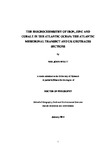The Biogeochemistry of iron, zinc and cobalt in the Atlantic Ocean: the Atlantic Meridional Transect and UK GEOTRACES sections
| dc.contributor.supervisor | Lohan, Maeve | |
| dc.contributor.author | Wyatt, Neil | |
| dc.contributor.other | School of Geography, Earth and Environmental Sciences | en_US |
| dc.date.accessioned | 2014-05-16T08:58:45Z | |
| dc.date.available | 2014-05-16T08:58:45Z | |
| dc.date.issued | 2014 | |
| dc.identifier | 329855 | en_US |
| dc.identifier.uri | http://hdl.handle.net/10026.1/3024 | |
| dc.description.abstract |
Between 40 % and 50 % of the Earth’s primary production occurs in marine environments, primarily by phytoplankton. The trace metal micronutrients iron, zinc and cobalt are known to exert a significant biological control on phytoplankton productivity by serving as essential active centres in enzymatic processes such as inorganic carbon, nitrogen and phosphorus acquisition. The distributions and biogeochemistries of iron, zinc and cobalt therefore, have the potential to impact upon the global carbon cycle and hence climate. This research involves investigations into the biogeochemical cycling of iron, zinc and cobalt in the Atlantic Ocean. Iron measurements were conducted during October and November 2009 to determine the distribution and biogeochemistry of iron in the upper water column of the Atlantic Ocean along an Atlantic Meridional Transect (AMT-19). In addition, deck board incubation experiments were performed to establish the role of iron in controlling rates of di-nitrogen (N2) fixation in the North Atlantic. The distribution patterns and biogeochemistries of iron, zinc and cobalt in the South Atlantic at 40° S were determined during the UK GEOTRACES Section GA10 cruises of October 2010 and December 2011 to January 2012. Iron distributions in North Atlantic surface waters were primarily controlled by the transport and deposition of atmospheric dust particles. In the North Atlantic, elevated surface dissolved iron concentrations (0.50 - 1.65 nM) were associated with wet and dry deposition of Saharan dust between 4 and 29° N. To the south of 4° N, surface dissolved iron concentrations were markedly reduced (0.14 nM) indicating that high precipitation rates in the Inter-Tropical Convergence Zone (4 - 10° N) formed a barrier to the large-scale transport of Saharan dust particles, thus iron, to the South Atlantic. Here, the low surface dissolved iron concentrations were balanced by a total dissolvable iron flux out of the surface mixed layer (3.2 µmol m-2 y-1) that was comparable to atmospheric input estimates. Nitrogen fixation rates in the North Atlantic were highest (0.3 – 1.1 nmol L-1 d-1) where surface dissolved iron concentrations were elevated (1.02 nM) and decreased with increasing latitude as iron decreased. Hence, iron variability in the North Atlantic was sufficient to influence nitrogen fixation over a large spatial scale. In the South Atlantic Ocean at 40° S, the vertical and horizontal distributions of dissolved zinc and cobalt showed distinct gradients associated with the water masses present. Zinc concentrations ranged from 15 pM in open ocean surface waters to 8 nM in Antarctic Bottom Waters, whilst cobalt ranged from 2 pM to 80 pM in intermediate waters and was scavenged in deeper waters. Growth limiting mixed layer zinc concentrations resulted from the lack of a direct return path for zinc to the South Atlantic pycnocline with Sub-Antarctic Mode Water. Low zinc in this return path was identified by a linear correlation between zinc and soluble reactive phosphorus that showed a kink at ~ 500 m, much deeper than that observed in other oceanographic regimes. A seasonal study in the Southeast Atlantic revealed that the depletion of zinc over spring-summer periods resulted in an increase in the nutritional importance of cobalt and a shift towards phytoplankton with a cellular preference for cobalt over zinc and/or the ability to co-substitute these two trace metals at the molecular level. These key findings demonstrate the physico-chemical and biological influences that interact to control the distributions and biogeochemistries of iron, zinc and cobalt across diverse oceanographic regimes of the Atlantic Ocean, provide the first examination of zinc and cobalt biogeochemistries along the productive 40° S parallel and highlight the need for additional research in this region. | en_US |
| dc.description.sponsorship | National Environmental Research Council | en_US |
| dc.language.iso | en | en_US |
| dc.publisher | University of Plymouth | en_US |
| dc.subject | Trace metal cycling | en_US |
| dc.subject | Biogeochemistry | en_US |
| dc.subject | Atlantic Ocean | en_US |
| dc.title | The Biogeochemistry of iron, zinc and cobalt in the Atlantic Ocean: the Atlantic Meridional Transect and UK GEOTRACES sections | en_US |
| dc.type | Thesis | |
| plymouth.version | Full version | en_US |
| dc.identifier.doi | http://dx.doi.org/10.24382/4168 |
Files in this item
This item appears in the following Collection(s)
-
01 Research Theses Main Collection
Research Theses Main


